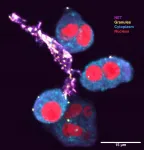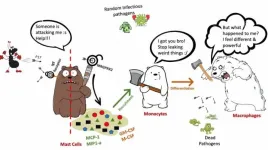(Press-News.org) DURHAM, N.C. -- You know your dog gets your gist when you point and say "go find the ball" and he scampers right to it.
This knack for understanding human gestures may seem unremarkable, but it's a complex cognitive ability that is rare in the animal kingdom. Our closest relatives, the chimpanzees, can't do it. And the dogs' closest relative, the wolf, can't either, according to a new Duke University-led study published July 12 in the journal Current Biology.
More than 14,000 years of hanging out with us has done a curious thing to the minds of dogs. They have what are known as "theory of mind" abilities, or mental skills allowing them to infer what humans are thinking and feeling in some situations.
The study, a comparison of 44 dog and 37 wolf puppies who were between 5 and 18 weeks old, supports the idea that domestication changed not just how dogs look, but their minds as well.
At the Wildlife Science Center in Minnesota, wolf puppies were first genetically tested to make sure they were not wolf - dog hybrids. The wolf puppies were then raised with plenty of human interaction. They were fed by hand, slept in their caretakers' beds each night, and received nearly round-the-clock human care from just days after birth. In contrast, the dog puppies from Canine Companions for Independence lived with their mother and littermates and had less human contact.
Then the canines were tested. In one test, the researchers hid a treat in one of two bowls, then gave each dog or wolf puppy a clue to help them find the food. In some trials, the researchers pointed and gazed in the direction the food was hidden. In others, they placed a small wooden block beside the right spot -- a gesture the puppies had never seen before -- to show them where the treat was hidden.
The results were striking. Even with no specific training, dog puppies as young as eight weeks old understood where to go, and were twice as likely to get it right as wolf puppies the same age who had spent far more time around people.
Seventeen out of 31 dog puppies consistently went to the right bowl. In contrast, none out of 26 human-reared wolf pups did better than a random guess. Control trials showed the puppies weren't simply sniffing out the food.
Even more impressive, many of the dog puppies got it right on their first trial. Absolutely no training necessary. They just get it.
It's not about which species is "smarter," said first author Hannah Salomons, a doctoral student in Brian Hare's lab at Duke. Dog puppies and wolf puppies proved equally adept in tests of other cognitive abilities, such as memory, or motor impulse control, which involved making a detour around transparent obstacles to get food.
It was only when it came to the puppies' people-reading skills that the differences became clear.
"There's lots of different ways to be smart," Salomons said. "Animals evolve cognition in a way that will help them succeed in whatever environment they're living in."
Other tests showed that dog puppies were also 30 times more likely than wolf pups to approach a stranger.
"With the dog puppies we worked with, if you walk into their enclosure they gather around and want to climb on you and lick your face, whereas most of the wolf puppies run to the corner and hide," Salomons said.
And when presented with food inside a container that was sealed so they could no longer retrieve it, the wolf pups generally tried to solve the problem on their own, whereas the dog puppies spent more time turning to people for help, looking them in the eye as if to say: "I'm stuck can you fix this?"
Senior author Brian Hare says the research offers some of the strongest evidence yet of what's become known as the "domestication hypothesis."
Somewhere between 12,000 and 40,000 years ago, long before dogs learned to fetch, they shared an ancestor with wolves. How such feared and loathed predators transformed into man's best friend is still a bit of a mystery. But one theory is that, when humans and wolves first met, only the friendliest wolves would have been tolerated and gotten close enough to scavenge on the human's leftovers instead of running away. Whereas the shyer, surlier wolves might go hungry, the friendlier ones would survive and pass on the genes that made them less fearful or aggressive toward humans.
The theory is that this continued generation after generation, until the wolf's descendants became masters at gauging the intentions of people they interact with by deciphering their gestures and social cues.
"This study really solidifies the evidence that the social genius of dogs is a product of domestication," said Hare, professor of evolutionary anthropology at Duke.
It's this ability that makes dogs such great service animals, Hare said. "It is something they are really born prepared to do."
Much like human infants, dog puppies intuitively understand that when a person points, they're trying to tell them something, whereas wolf puppies don't.
"We think it indicates a really important element of social cognition, which is that others are trying to help you," Hare said.
"Dogs are born with this innate ability to understand that we're communicating with them and we're trying to cooperate with them," Salomons said.
INFORMATION:
This research was supported by the Office of Naval Research (N00014- 16-12682), the Eunice Kennedy Shriver National Institute of Child Health and Human Development of the National Institutes of Health (NIH-1Ro1HD097732) and the AKC Canine Health Foundation (#2700).
CITATION: "Cooperative Communication with Humans Evolved to Emerge Early in Domestic Dogs," Hannah Salomons, Kyle Smith, Megan Callahan-Beckel, Margaret Callahan, Kerinne Levy, Brenda S. Kennedy, Emily Bray, Gitanjali E. Gnanadesikan, Daniel J. Horschler, Margaret Gruen, Jingzhi Tan, Philip White, Evan MacLean, Brian Hare. Current Biology, July 12, 2021. DOI: 10.1016/j.cub.2021.06.051
Astronomers have made the rare sighting of two stars spiralling to their doom by spotting the tell-tale signs of a teardrop-shaped star.
The tragic shape is caused by a massive nearby white dwarf distorting the star with its intense gravity, which will also be the catalyst for an eventual supernova that will consume both. Found by an international team of astronomers and astrophysicists led by the University of Warwick, it is one of only very small number of star systems that has been discovered that will one day see a white dwarf star reignite its core.
New research published by the team today (12 July) in Nature Astronomy confirms that the two stars are ...
Researchers from the Buck Institute and Stanford University have created an inflammatory clock of aging (iAge) which measures inflammatory load and predicts multi-morbidity, frailty, immune health, cardiovascular aging and is also associated with exceptional longevity in centenarians. Utilizing deep learning, a form of AI, in studies of the blood immunome of 1001 people, researchers also identified a modifiable chemokine associated with cardiac aging which can be used for early detection of age-related pathology and provides a target for interventions. Results are published in Nature Aging.
"Standard immune metrics which can be used to identify individuals most at risk for developing single or even multiple chronic diseases ...
According to the study, Australia, Indonesia and the USA provide the largest carbon storage potential with their coastal ecosystems. The team also calculated which countries benefit most from the coastal CO2 uptake worldwide. The different ways in which countries are affected by climate change are quantified by using the so-called social costs of carbon.
"If we take into account the differences in marginal climate damages that occur in each country, we find that Australia and Indonesia are clearly the largest donors in terms of globally avoided climate damages originating from coastal CO2 uptake, as they themselves derive comparatively little benefit ...
Many exoplanets have opaque atmospheres, obscured by clouds or hazes that make it hard for astronomers to characterize their chemical compositions. A new study shows that haze particles produced under different conditions have a wide range of properties that can determine how clear or hazy a planet's atmosphere is likely to be.
Photochemical reactions in the atmospheres of temperate exoplanets lead to the formation of small organic haze particles. Large amounts of these photochemical hazes form in Earth's atmosphere every day, yet our planet has relatively clear skies. The reason has to do with how ...
A diet rich in fermented foods enhances the diversity of gut microbes and decreases molecular signs of inflammation, according to researchers at the Stanford School of Medicine.
In a clinical trial, 36 healthy adults were randomly assigned to a 10-week diet that included either fermented or high-fiber foods. The two diets resulted in different effects on the gut microbiome and the immune system.
Eating foods such as yogurt, kefir, fermented cottage cheese, kimchi and other fermented vegetables, vegetable brine drinks, and kombucha tea led to an increase in overall microbial diversity, with stronger effects from larger servings. ...
You're as old as your immune system.
Investigators at the Stanford University School of Medicine and the Buck Institute for Research on Aging have built an inflammatory-aging clock that's more accurate than the number of candles on your birthday cake in predicting how strong your immune system is, how soon you'll become frail or whether you have unseen cardiovascular problems that could become clinical headaches a few years down the road.
In the process, the scientists fingered a bloodborne substance whose abundance may accelerate cardiovascular aging.
The story of the clock's creation will be published July 12 in Nature Aging.
"Every year, the calendar tells us we're a year older," said David ...
The cave of Satsurblia was inhabited by humans in different periods of the Paleolithic: Up to date a single human individual dated from 15,000 years ago has been sequenced from that site. No other human remains have been discovered in the older layers of the cave.
The innovative approach used by the international team led by Prof. Ron Pinhasi and Pere Gelabert with Susanna Sawyer of the University of Vienna in collaboration with Pontus Skoglund and Anders Bergström of the Francis Crick Institute in London permits the identification of DNA in samples of environmental ...
Boosting the body's own disease-fighting immune pathway could provide answers in the desperate search for new treatments for tuberculosis.
Tuberculosis still represents an enormous global disease burden and is one of the top 10 causes of death worldwide.
Led by WEHI's Dr Michael Stutz and Professor Marc Pellegrini and published in Immunity, the study uncovered how cells infected with tuberculosis bacteria can die, and that using new medicines to enhance particular forms of cell death decreased the severity of the disease in a preclinical model.
At a glance
Researchers were able to demonstrate that cells infected with tuberculosis bacteria have functional ...
Ants are omnipresent, and we often get blisters after an ant bite. But do you know the molecular mechanism behind it? A research team led by Professor Billy K C CHOW from the Research Division for Molecular and Cell Biology, Faculty of Science, the University of Hong Kong (HKU), in collaboration with Dr Jerome LEPRINCE from The Institut national de la santé et de la recherche médicale (INSERM) and Professor Michel TREILHOU from the Institut National Universitaire Champollion in France, have identified and demonstrated a novel small peptide isolated from the ant venom can initiate an immune pathway via a pseudo-allergic receptor MRGPRX2. The study ...
Rather than waiting for certainty in sea-level rise projections, policymakers can plan now for future coastal flooding by addressing existing inequities among the most vulnerable communities in flood zones, according to Stanford research.
Using a methodology that incorporates socioeconomic data on neighborhood groups of about 1,500 people, scientists found that several coastal communities in San Mateo County, California - including half the households in East Palo Alto - are at risk of financial instability from existing social factors or anticipated flooding through 2060. Even with coverage from flood insurance, these residents would not be able to pay for damages from flooding, which could lead to homelessness or bankruptcy ...






